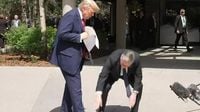In a significant development at the 2025 G7 summit held in Kananaskis, Alberta, Canadian Rockies, US President Donald Trump and British Prime Minister Keir Starmer announced the signing of a trade agreement aimed at reducing tariffs on British automotive and aerospace industries. The deal, hailed by both leaders as a milestone, promises to ease trade tensions and bolster key sectors on both sides of the Atlantic. Yet, despite the fanfare, the thorny issue of steel tariffs remains unresolved, underscoring ongoing complexities in the transatlantic trade relationship.
The agreement, which builds upon a framework reached in May 2025, sets an annual quota of 100,000 British cars to be imported into the United States at a reduced tariff rate of 10%, down from the previous 27.5%. This significant reduction offers a lifeline to the UK’s automotive sector, which had been bracing for steep tariffs under earlier US policies. Likewise, the aerospace industry will benefit from the complete removal of US tariffs on British aerospace products, including parts and aircraft. This exemption is a boon for companies like Rolls-Royce, which stand to gain from unfettered access to the lucrative American market.
Prime Minister Starmer described the deal as “a very good day for both our countries, a real sign of strength,” while President Trump, in his characteristically ebullient style, praised Starmer for achieving what others had failed to do in years of post-Brexit negotiations. “The UK is very well protected. You know why? Because I like them – that’s their ultimate protection,” Trump quipped to reporters, underscoring the personal rapport that seemed to underpin the agreement.
However, the celebrations were tempered by the unresolved status of steel tariffs. Although the UK continues to avoid the US’s global 50% tariff on steel and aluminum, British steel still faces a 25% tariff. The original expectation, as declared by the UK government in early May, was a full elimination of these tariffs, which would have been a vital boost to the struggling British steel industry. Britain’s steel output has plummeted by 80% since the late 1960s, and the sector has been eagerly awaiting tariff relief to remain competitive.
The US administration’s executive order implementing the deal highlighted concerns about the security of supply chains and the ownership of British steel production facilities, particularly those owned by Jingye Group, a Chinese company with control over British Steel. The UK government took control of British Steel in April to prevent the closure of the Scunthorpe plant, but the US remains wary of potential circumvention of tariffs through this ownership structure. As a result, the US Secretary of Commerce, in consultation with the US Trade Representative, will determine a tariff quota for British steel, aluminum, and derivative products that can enter the US duty-free. The UK government has reiterated its commitment to achieving zero tariffs on core steel products as agreed, but the final details are still being negotiated.
The deal also includes provisions for reciprocal agricultural trade, allowing American farmers to export 13,000 metric tons of beef to the UK annually, with British farmers granted similar access to the US market. This arrangement, however, maintains the UK’s ban on hormone-treated beef, a contentious issue in transatlantic trade talks. The inclusion of bioethanol in trade agreements has sparked concern among British farmers, with the National Farmers Union warning that it could threaten profit margins.
Business and Trade Secretary Jonathan Reynolds hailed the agreement as a crucial lifeline for UK workers, emphasizing that the deal protects “jobs and livelihoods in some of our most vital sectors.” Mike Hawes, chief executive of the Society of Motor Manufacturers and Traders, called it “great news for the UK automotive industry,” highlighting the deal’s positive impact on a sector that had faced significant uncertainty amid trade tensions.
Despite these advances, the UK’s trade deficit with the US has grown, with the Office for National Statistics reporting the sharpest drop in monthly UK exports to the US since records began. Economists caution that the UK may still face challenges from broader trade disruptions, particularly as the US considers imposing a baseline 10% tariff on all other goods imported from the UK and other countries in the near future.
During the announcement, President Trump mistakenly referred to the deal as one with the European Union, a slip that underscored the complexity and breadth of ongoing trade negotiations. Nevertheless, he expressed optimism about future agreements, hinting at potential deals with the EU and other partners. “We have many, many other ones coming,” Trump said, reflecting his administration’s broader trade agenda.
Downing Street also revealed that Prime Minister Starmer planned to use the G7 summit to push for new sanctions on Russia and efforts to resolve conflicts in the Middle East, indicating that trade discussions are just one facet of the UK’s broader diplomatic engagements.
The British government continues to work diligently to ensure that Tata Steel, the country’s largest steel producer operating the Port Talbot mill, retains duty-free access to the US market under the trade agreement. Tata Steel had expressed concerns about being excluded due to the origin of some of its products, highlighting the delicate balance between trade policy and industrial realities.
In summary, the UK-US trade deal signed at the G7 summit marks a significant step forward in reducing barriers for British automotive and aerospace exports to the United States, offering much-needed relief to key industries. Yet, the unresolved steel tariffs and ongoing negotiations over supply chain security reflect the complexities of modern trade agreements, especially amid geopolitical concerns and shifting global alliances. As both sides continue their talks, businesses and workers on both sides of the Atlantic will be watching closely to see how these issues are ultimately resolved.


